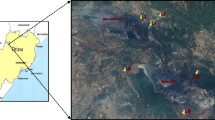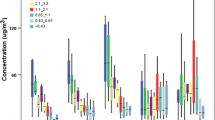Abstract
This study gives insight into the spatiotemporal variability of respirable PM concentrations around typically highly mechanized opencast coal mines in India and its influence on ambient air quality, which at present is scant in the literature. The results suggest that at a distance of 500 m from the pit boundary, the respirable PM concentrations were found higher than the background concentration (1.52, 1.80 and 1.89 times for PM10, PM2.5 and PM1 at Mine 1 and 1.4, 1.35 and 1.35 times for PM10, PM2.5 and PM1 at Mine 2) which suggests that residents up to and beyond 500 m from the mine are exposed to the PM emitted from mining activities. For PM2.5 and PM1 concentrations, RH was the most important determinant (PM2.5: 24.8%; PM1: 30.1%). Pit boundary PM concentration was the weakest determinant (7%) for the PM2.5 concentration in mine surroundings, and wind speed was found as the weakest determinant (6.6%) for PM1 concentration. Conversely, distance (20.8%) was the important determinant of PM10 concentrations. All the four predictors (RH, wind speed, distance and Pit boundary PM concentration) could explain 46–54% variability in the PM concentrations. Inclusion of pit boundary PM concentration as a predictor increased the prediction capability of the models (all the developed models have R2 > 0.40 at significance level p < 0.05). PM prediction models can be used by the mining and regulatory authorities to assess the respirable PM level in mine surroundings.

Source: Google Earth)

Source: Google Earth)





Similar content being viewed by others
References
Adams, H. S., Nieuwenhuijsen, M. J., & Colvile, R. N. (2001). Determinants of fine particle (PM2.5) personal exposure levels in transport microenvironments, London UK. Atmospheric Environment, 35(27), 4557–4566.
CPCB. (2009). http://cpcb.nic.in/National_Ambient_Air_Quality_Standards.php. (accessed on September 28, 2020).
Dash, T. R., Tripathy, D. P., & Pandey, J. K. (2020). Chemical characterization of PM10 and evaluation of health risk for the people residing around a highly mechanized opencast coal mine using FTIR spectroscopy. Arabian Journal of Geosciences , 13(4), 1–17.
Dinoi, A., Donateo, A., Belosi, F., Conte, M., & Contini, D. (2017). Comparison of atmospheric particle concentration measurements using different optical detectors: Potentiality and limits for air quality applications. Measurement, 106, 274–282.
Dubey, B., Pal, A. K., & Singh, G. (2012). Trace metal composition of airborne particulate matter in the coal mining and non–mining areas of Dhanbad Region, Jharkhand. India Atmospheric Pollution Research, 3(2), 238–246.
Espitia-Pérez, L., Arteaga-Pertuz, M., Soto, J. S., Espitia-Pérez, P., Salcedo-Arteaga, S., Pastor-Sierra, K., Galeano-Páez, C., Brango, H., da Silva, J., & Henriques, J. A. (2018). Geospatial analysis of residential proximity to open-pit coal mining areas in relation to micronuclei frequency, particulate matter concentration, and elemental enrichment factors. Chemosphere, 206, 203–216.
Gautam, S., & Patra, A. K. (2015). Dispersion of particulate matter generated at higher depths in opencast mines. Environmental Technology Innovation, 3, 11–27.
George, K. V., Patil, D. D., & Alappat, B. J. (2013). PM10 in the ambient air of Chandrapur coal mine and its comparison with other environments. Environmental Monitoring and Assessment, 185(2), 1117–1128.
Grimm. (2010). Operational manual of portable laser aerosol spectrometer and dust monitor (Model 1.108/1.109). GRIMM Aerosol Technik GmbH & Co. KG, Ainring, Germany. https://www.grimm-aerosol.com/.
Jaiprakash, S., Singh, G., & Pal, A. K. (2010). Air pollution dispersion modeling performance for mining complex. Environment and We an International Journal of Science Technology, 5, 205–222.
Jena, S., & Singh, G. (2017). Human health risk assessment of airborne trace elements in Dhanbad. India. Atmos. Pollut. Res., 8(3), 490–502.
Kaur, S., & Nieuwenhuijsen, M. J. (2009). Determinants of personal exposure to PM2.5, ultrafine particle counts, and CO in a transport microenvironment. Environment Science Technology, 43(13), 4737–4743.
Kolluru, S. S. R., Patra, A. K., & Sahu, S. P. (2018). A comparison of personal exposure to air pollutants in different travel modes on national highways in India. Science of the Total Environment, 619–620, 155–164.
Kumar, A., Elumalai, S. P. (2021). Study on respiratory deposition doses of typical Indian opencast coal mineworkers using occupational particulate matter levels. Air Quality Atmosphere & Health, 14,1247–1265.
Kundu, S., & Pal, A. K. (2015). The evaluation of airborne respirable particulates in opencast mining area of Jharia Coalfield using Grimm 1.109 real-time portable aerosol spectrometer. Journal Biodivers Environment Science, 6(4), 276–287.
Landau, S., & Everitt, B. S. (2004). A handbook of statistical analyses using SPSS. Chapman and Hall/CRC.
Liu, Y., Wang, R., Zhang, Y., Zhao, T., Wang, J., Wu, H., & Hu, P. (2020). Temporal and spatial distributions of particulate matters around mining areas under two coal mining methods in arid desert region of northwest China. Environmental Technology&. Innovation, 19, 101029.
Mandal, K., Kumar, A., Tripathi, N., Singh, R. S., Chaulya, S. K., Mishra, P. K., & Bandyopadhyay, L. K. (2012). Characterization of different road dusts in opencast coal mining areas of India. Environmental Monitoring and Assessment, 184(6), 3427–3441.
Manoj, K., & Padhy, P. K. (2014). Multivariate statistical techniques and water quality assessment: Discourse and review on some analytical models. International Journal of Environmental Sciences, 5(3), 607–626.
Nagesha, K. V., Kumar, H., & Singh, M. M. (2019). Development of statistical models to predict emission rate and concentration of particulate matters (PM) for drilling operation in opencast mines. Air Quality Atmosphere and Health, 12(9), 1073–1079.
Nazif, A., Mohammed, N. I., Malakahmad, A., & Abualqumboz, M. S. (2016). Application of step-wise regression analysis in predicting future particulate matter concentration episode. Water Air and Soil Pollution, 227(4), 117.
Onder, M., & Yigit, E. (2009). Assessment of respirable dust exposures in an opencast coal mine. Environmental Monitoring and Assessment, 152(1), 393–401.
Patra, A. K., Gorai, A. K., Rengde, V. R., & Sharma, Y. (2020). GIS-based exposure assessment and characterization of particulate matter in a mining region in India. Environment Development and Sustainability, 23(7), 1–23.
Rivas, I., Kumar, P., Hagen-Zanker, A., Andrade, M. F., Slovic, A. D., Pritchard, J. P., & Geurs, K. T. (2017). Determinants of black carbon, particle mass and number concentrations in London transport microenvironments. Atmospheric Environment, 161, 247–262.
Rojano, R. E., Manzano, C. A., Toro, R. A., Morales, R. G., Restrepo, G., & Leiva, M. A. (2018). Potential local and regional impacts of particulate matter emitted from one of the world’s largest open-pit coal mines. Air Quality Atmosphere and Health, 11(5), 601–610.
Roy, D., Gautam, S., Singh, P., Singh, G., Das, B. K., & Patra, A. K. (2016). Carbonaceous species and physicochemical characteristics of PM10 in coal mine fire area—a case study. Air Quality Atmosphere and Health, 9(4), 429–437.
SAAQIS (2009). http://www.saaqis.org.za/Downloads.aspx?type=AQ. (Accessed on September 18, 2020).
Sahu, S. P., & Patra, A. K. (2020). Development and assessment of multiple regression and neural network models for prediction of respirable PM in the vicinity of a surface coal mine in India. Arabian Journal of Geosciences, 13(17), 1–16.
Sahu, S. P., Patra, A. K., & Kolluru, S. S. R. (2018a). Spatial and temporal variation of respirable particles around a surface coal mine in India. Atmospheric Pollution Research, 9(4), 662–679.
Sahu, S. P., Yadav, M., Pradhan, D. S., Rani, N., & Das, A. J. (2018b). Spatio-temporal variations of respirable particles at residential areas located in the vicinity of opencast coal projects, India: A case study. Arabian Journal of Geosciences , 11(10), 241.
Samara, C., Argyropoulos, G., Grigoratos, T., Kouras, Α, Manoli, Ε, Andreadou, S., Pavloudakis, F., & Sahanidis, C. (2018). Chemical characterization and receptor modeling of PM10 in the surroundings of the opencast lignite mines of Western Macedonia Greece. Environmental Science Pollution Research, 25(13), 12206–12221.
Sastry, V. R., Chandar, K. R., Nagesha, K. V., Muralidhar, E., & Mohiuddin, M. S. (2015). Prediction and analysis of dust dispersion from drilling operation in opencast coal mines. Procedia Earth Planetary Science, 11, 303–311.
Singh, G. (2006). An index to measure depreciation in air quality in some coal mining areas of Korba industrial belt of Chhattisgarh India. Environmental Monitoring and Assessment, 122(1–3), 309–317.
Tecer, L. H., Süren, P., Alagha, O., Karaca, F., & Tuncel, G. (2008). Effect of meteorological parameters on fine and coarse particulate matter mass concentration in a coal-mining area in Zonguldak Turkey. Journal Air Waste Management Association, 58(4), 543–552.
Tiwari, S., Bisht, D. S., Srivastava, A. K., Pipal, A. S., Taneja, A., Srivastava, M. K., & Attri, S. D. (2014). Variability in atmospheric particulates and meteorological effects on their mass concentrations over Delhi India. Atmospheric Research, 145, 45–56.
Tripathy, D. P., Dash, T. R., Badu, A., & Kanungo, R. (2015). Assessment and modelling of dust concentration in an opencast coal mine in India. Global Nest Journal, 17(4), 825–834.
Trivedi, R., Chakraborty, M. K., & Tewary, B. K. (2009). Dust dispersion modeling using fugitive dust model at an opencast coal project of Western Coalfields Limited India. Journal of Scientific and Industrial Research, 68, 71–78.
Yadav, S.K., Jain, M K., 2020. Variation in concentrations of particulate matter with various sizes in different weather conditions in mining zone. International Journal Environmental Science Technology, 17, 695–708.
Author information
Authors and Affiliations
Corresponding author
Additional information
Publisher's Note
Springer Nature remains neutral with regard to jurisdictional claims in published maps and institutional affiliations.
Supplementary Information
Below is the link to the electronic supplementary material.
Rights and permissions
About this article
Cite this article
Sahu, S.P., Patra, A.K. Assessment of dispersion of respirable particles emitted from opencast mining operations: development and validation of stepwise regression models. Environ Dev Sustain 24, 9139–9164 (2022). https://doi.org/10.1007/s10668-021-01816-z
Received:
Accepted:
Published:
Issue Date:
DOI: https://doi.org/10.1007/s10668-021-01816-z




